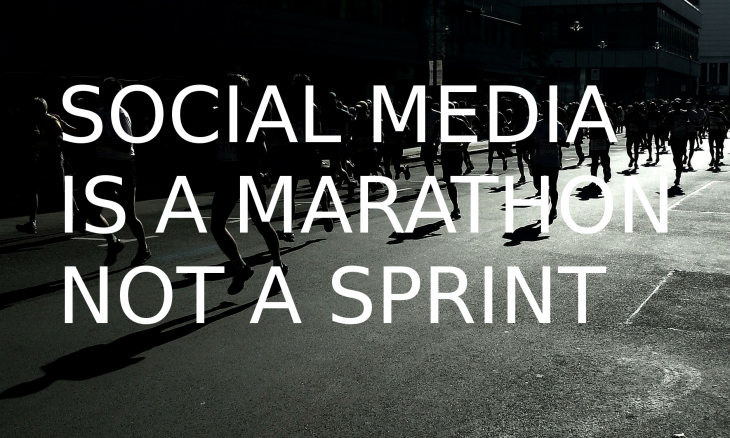
I have been doing social media strategy and planning in one form or another for clients since 2003. Nothing at all has changed. In fact, nothing has changed since Homo sapiens emerged around 300,000 years ago. No matter how evolved, enlightened, and space-age we feel we are in today’s modern internet era, we possess the very same human nature we’ve always had. We crave community, belonging, and we also fancy ourselves much more independent and autonomous than we obviously are in any real capacity. Agency, my ass.
Yes, it seems like maybe we’re savvier these days in influencing us cavemen than we were millennia ago, though I believe that the existence of culture, nation-states, currency, politics, ideology, colonialism, war, and religion may well suggest that social media marketing predates the Internet and social networks by at least ten-thousand years.
But in the context of social media and social media marketing, here’s how I break it down. Remember, we’re basically hunter-gatherers with thousand-dollar Cray Supercomputer in our pockets, allowing us to hunt for deals and gather friends — all without needing to leave your couch and set out to the tundra permafrost in search of snowshoe rabbits.
Social Media Monitoring
People are already talking you and your brand. And, once you launch a social media campaign, being it advertising, influencer outreach, online engagement, or content marketing, monitoring and accountability are essential parts of any modern marketing and PR campaign.
Even if you’re not interested in sales conversions, it’s essential to be able to see and interpret what the impact of your social media marketing campaign is. Monitoring turns a series of unrelated social media behaviors into more of a science laboratory where you can experiment.
Where you can actually see where all the hard work you’re doing with your social media marketing, content marketing, and online PR comes to fruition. You can better audit how actions have reactions and you can do A/B/C testing so that you can optimize all your work to better serve your missions and goals.
Social Media Planning and Calendaring
Even today, social media is often not integrated into the greater corporate strategy. As a result, companies too often make up their social media marketing as they go along, ad hoc, reacting to content and information and updated they get as they get them, tactically instead of strategically.
Not unlike any editorial calendar used by magazines and newspapers, planning social media output and engagement over the course of a calendar, month-by-month, allows brands and companies to develop content that recurs annually. They can also develop content that dovetails with all the unique national, state, and local holidays, memorial days, and awareness days.
Every day of the year has one or more issues on that day, sort of like the name day calendar used in many Catholic countries. Instead of a patron Saint’s name, there’s national beer day on April 7th and national jellybean day on April 22nd, for example. Imagine what you can do if you had the entire year planned out, awareness days and multicultural holidays and important events in history and even important events in your brand’s history!
Social Media Marketing/Social Media Promotion
Social media marketing (SMM) isn’t just one thing. While some believe that social media should only be a platform for the engagement of people by brands via people, I’m of the camp that believes in the 80/20 rule (more like 70/30 in the real world). What I mean by this is that your social media channels are akin to your own personal wire services. While RSS and ATOM syndication is not very commonplace anymore, opt-in subscription newsletters, Twitter, Facebook, and the rest, can be used by your PR department to share just the kind of information that you’d generally plan for all the PR Newswires of the world.
While brand, product, and service-promotion should really only be 20%-30% of all the content shared via social media channels, too many companies are afraid of spending any of their time doing shameless self-promotion. It’s OK. If they follow you they already have taken a strong step towards loving you already. Like all networking or social opportunities, it’s essential to make authentic and personal connections; however, networking isn’t about making friends of collecting people, it’s about moving the ball forward.
Never be afraid of pitching, selling, engaging, facilitating, supporting, and proving the sort of solutions that drives you forward towards the goal—converting, transitioning, engaging, subscribing, and—ultimately—selling. While social media can and does act in the service of customer relations and customer support, it should also be a place where you can tout your wares.
Social Media Automation
Unlike many things in life, you can run a social media marketing campaign as a bit of a one-man band. There are so many tools that allow you to automate and semi-automate your social media sharing, response, and engagement.
Even if you have an entire marketing team with several people devoted to social media marketing, it’s always worthwhile to outsource all the tedium and busy work that keeps social media marketers from their creativity and from innovating and exploring and doing the kind of social experimentation that might actually result in some real success.
For example, just like radio and television is always pausing for the news and for station identification, every social media channel should intersperse your own news and your own business identification (with links and hashtags)—and all of those things can very well be automated.
Social Media Development
Every social profile starts with zero likes, subscribers, followers, or friends. Even mature social media sites are often plateaued at under ten-thousand, even under a thousand! This really doesn’t look right, especially when it doesn’t vibe well with the perceived popularity of a brand in real life (IRL).
Having too few followers is always more of a red flag than having too many. In a world where even the President of the USA pays for followers, it’s actually pretty essential for brands that are starting up or launching—or still in the doldrums of having fewer than 500 followers—to buy ten-thousand from a site like FastFollowerz, for example, in order to make sure your brand perception is in line with how many followers you have.
Besides, until you have over 10,000 followers/likes/subscribers, Twitter and YouTube and Facebook still have their leash on you. Once you attain a level of popularity, even if it’s inorganic, then you’ll have a lot more freedom. It comes down to this: nobody wants to disco in an empty club. And nobody ever checks to see if the prettiest dancers are locals or if they’re actually models hired from an agency.
Other methods include cross-platform promotion, the inclusion of social media sites every piece or promotional material both online and in real life (letterhead, in stores, in ads, etc). There are many methods for developing membership, a fanbase, a followership, and ultimately converting your screaming fans into loyal paying customers.
Social Media Strategy
If you build it, they probably won’t come. While social media is generally handed tactically and in reaction to what’s happening in the world. While you can’t prepare for everything that could potentially happen in the wilderness of the internet. Developing a strategy is essential towards making sure that social media speaks in the same tone, at the same pace, and in the same voice as the rest of the company.
If you use it as customer support, it should strategize with customer support. If it’s brand promotional, it should work closely with marcom, and if it’s being used as part of the sales channel, the strategy needs to dovetail with sales. Generally-speaking, most social media campaigns are connected closely at the CMO level since their success and failure seems always to be of interest to a company’s Board of Directors.
In Conclusion
We humans really hate the think we’re the same provincials we were 300 millennia ago. That we have the same mental and physical abilities we had 15,000 generations ago. Even if we consider human culture only 10,000 years ago, that’s still 500 generations of standing still while imagining that we’re speeding along at 17,500 miles per hour. So, rely on human nature. Knowing human nature and group-think are always good home bases every time you get caught up in technology. To quote the Bard, “People are people so why should it be, you and I should get along so awfully?” Amen.
Feel free to own the yacht but hire a crew if you’re not yet seaworthy. If you get my drift and want to adopt the yachting lifestyle yourself but either don’t have the mad sailing skills yourself, don’t yet possess a world-class crew, and don’t know yet where to go, then you should give me a call or reach out me by email — so I can help you pilot your vessel now, in the tranquil blue-green shallows of the Caribbean, as well as in the roughest seas and into — as well as out of — the storm.
If you’d like to chat more, call me at +1 (202) 869-3210 Ext 0001 email me, or feel free to self-schedule a 15-minute call, a 30-minute call, or a 60-minute call with me.




